A day in Le Corbusier's Utopia
After I walked home from the internet place last time I updated, I was frustrated that I wasn’t able to accurately describe the chaos of Delhi. Then I remembered: You have a video camera in your pocket, idiot! Here’s the area near my hotel — it gets even more intense than this once you add vehicles and animals into the mix:
The following morning, I jumped on a super-comfortable air-conditioned train headed north to Chandigarh the capital of the state of Punjab. The city is unlike any other in India: it is the planned vision of one man, and is considered to be the greenest, cleanest, and most orderly city in the country.
First, a little history. When India gained independence from Britain in 1947, the massive country was partitioned into three pieces based largely on religious divides within the country. The main Muslim area to the northwest was named Pakistan, the middle Hindu area remained India, and the Muslim area to the northeast became Bangladesh. The majority of the state of Punjab — mostly Hindu and Sikh — remained in India, but its capital Lahore became a part of Pakistan. Punjab was without a capital, and someone along the way decided that the state should just create a new city from scratch. After a long search for architects and planners, Punjab settled on famed Swiss-born French architect Le Corbusier to plan and design a modern metropolis. Only somewhat familiar with Le Corbusier, and with a growing interest in urban planning, I decided to make the trip to Chandigarh to learn more.
Side note: My brother Bill emailed me about the above history being partially incorrect, especially with regard to the formation of Bangladesh. But hey, what did you expect from someone who majored in design rather than history?
I arrived in the train station and was taken by auto-rickshaw through along Corbusier’s organized and orderly roads to Sector 17, the main part of town, where I got dropped off at the hectic bus station. Along the way I saw street after street of what looked to me like uninspired strip malls. Sure, there were a few really nice spots, but overall it looked a lot more like a sketchy area in LA than it did like Utopia. Crumbling utilitarian concrete structures filled every block — parts even reminded me of the war torn buildings I saw a few years ago in post-war Bosnia. There was no war here, however: just the remains of one man’s attempt at building a utopian city, fifty years later. Although I was determined to keep an open mind, one thought kept passing through my mind: holy crap, Le Corbusier was an idiot.
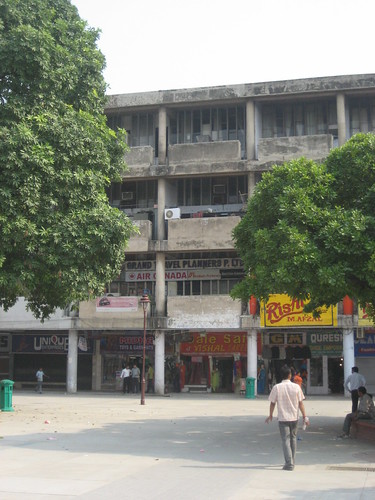
To try to make sense of this strange place, I walked to the nearby City Museum which carefully documents the planning and realization of Chandigarh all the way from India’s independence to present day. I spent several hours in the small museum poring over each display, trying to understand why such a smart architect would have intentionally created such a city. The more I explored the museum, the more I appreciated what Corbu was trying to accomplish. He planned residential areas close to restaurants and retail, but made sure to keep a buffer between high traffic streets and people’s homes. Schools, churches and parks were built within each half-mile sector so that each sector would become its own walkable neighborhood. Many of his ideas sounded strikingly similar to theories behind contemporary mixed-use town planning found in places like Belmar, Bradburn and Stapleton back in Denver. So what went wrong in Chandigarh? I headed back out into the city to try and find out.
I walked through Corbusier’s “Leisure Valley,” a pleasant park that stretches through the city on my way to the Corbu-designed government buildings in Sector 1. When I reached the area, I was again shocked by the unfortunately designed structures I found. A founder of the Purism movement, Le Corbusier believed that disguising or decorating a building’s structure — the concrete, brick and glass — takes away from the building’s purity. He also designed everything to be in harmony with the golden ratio, considered to be proportionately ideal. As a result, Corbusier only built “pure” buildings: huge perfectly-proportioned blocks of concrete. While I value the ideas behind his buildings and he was certainly part of an important era in the history of architecture, I think his buildings ultimately fail to connect and resonate with regular people, myself included.
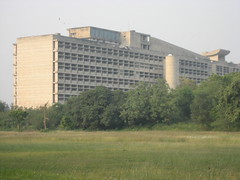
I was getting sick of all the concrete and ghost-town plazas, so my next stop took me a few blocks away to another surreal place, again created by the vision and creativity a single person: Chandigarh’s Fantasy Rock Garden, created over thirty years by a local road inspector named Nek Chand. The surreal and whimsical place is full of pouring waterfalls, tiny weaving passageways, and hundreds of quirky sculptures made largely out of trash: broken dishes, discarded bracelets, and plastic electrical parts. The enormous place serves as a monument to Nek Chand’s incredible imagination, inspiring kids and adults alike to laugh and point with amazement as they wander the weird and wonderful place. There’s a shot of one of the bracelet sculptures below, but many more from other people here.
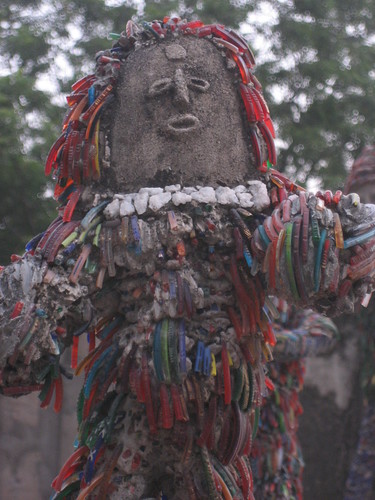
I headed over to the nearby Corbusier-made lake as night fell, where the whole town gathers every night for food, fun and people watching. This was the first truly successful Corbusier-creation I had seen yet — the small plaza was packed and everyone was having a great time.
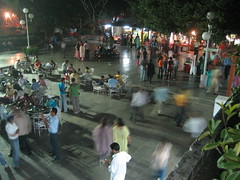
I met a few groups of funny Indian guys who rattled off question after question to me about my life in America. Besides the standard two questions (Are you married? Do you have a girlfriend?), one guy asked me what I thought was the single biggest difference between America and India. I stupidly said something about America being really clean compared to India, which, although true, was unintentionally offensive. The more I thought about it, the biggest difference I’ve seen revolves around gender. Men here seem to exclusively associate with other men, and women with women, unless a marriage is involved. The guys found it completely unfathomable that I could possibly have friends that are girls — the concept is seriously alien to them. Marriages here are still mostly arranged by parents, but there is a shocking western trend coming into India: “love marriages.” While we walked along the lake, one guy whispered, look, there’s some western culture!, pointing to a scandalous couple making out behind a tree. Meanwhile, guys are constantly showing affection for each other publicly — it is normal here for guys to have their arms around each other or hold hands while they walk. After answering all the guys questions, I went with a few of them to one of their favorite fast food places where they stuffed me full of cheese dosa, sort of like a crepe or thin pancake. Here are all of the guys hanging out near the lake:
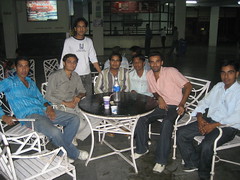
The next morning I walked around Sector 22 where my hotel was located, trying to get one last feel for Le Corbusier’s vision. Wandering through the residential area and seeing the built-in schools, parks and churches, it was clear to me that his ideas weren’t all bad. In my view, the biggest of Le Corbusier’s failures is the lack of architectural diversity and interest throughout the city. If he had gathered a group of fellow architects and had them each create five residences for his new city, then distributed each design around, the whole thing might have turned out better. If Corbu’s city was based upon the needs of people, he surely should have understood the basic idea that people are all different. Shouldn’t the architecture reflect that same diversity? But in the end, so long as I kept my eyes squinted a little bit, the city actually seemed like a fairly pleasant place to live. Indian people must agree: Chandigarh is considered to be one of the most posh and upscale cities in the country. I would love to return to the city in thirty years and see how Corbu’s city evolves along with India’s rise to superpower status in the world.
I’m currently in Shimla, an wonderful old British-era hill station, which has a very European feel and is apparently quite popular with Indians on their honeymoon. My quirky hotel room here looks like the smallest cabin inside an Eastern European cruise ship, or as my guidebook describes it, concrete bunker chic. I’ve spent the last day wandering around Shimla’s mock-Tudor architecture, and enjoying the people watching on the main pedestrian mall. I’ll write a bit more on Shimla later, but for now thanks for reading.
Ryan!
Also, a quick side note: Congratulations to my home city of Denver for being bold enough to complete Daniel Libeskind’s controversial design for the new wing of the Denver Art Museum, which opened to the public while I was in Chandigarh. I personally love it and some people hate it, but regardless of whether the building is ultimately “good” or “bad,” it seems clear to me now that more architectural diversity around town is almost always a good thing.
3 Comments:
Ry guy,
Hey, thanks for writing so much, to keep me looking like i'm doing something at work. In truth, I am not. I went to that new art museum last weekend for the grand free opening, it is indeed quite amazing. I too am proud to have such a structure in our fair city. I hope that you are sitting comfortably.
Hello Ryan, Ben Mills here in Longmont CO.
Just wanted to tell you how much I am enjoying your blog. You really capture your surroundings well. Your phots are amazing and are a wonder to see.
Keep it up!
Ben
Hey
I read about your blog on t-hypes blog. I just wanna say you cannot apply western morality on Indians. Indians have different set of cultural and moral values. India was ruled by invading/outside forces for close to 500 years. While muslim invaders assimilated into the Indian culture, they also assimilated some of their conservative values in to Indian culture. British never bothered, because they just sucked the blood out of India to make money. Why do you think a land of kamasutra is so conservative now? Think about it
Post a Comment
<< Home